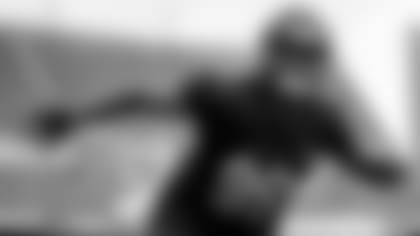The original Bengals uniform pictured here debuted when the team began play in the modern-era American Football League in 1968, and it defined the team's appearance well beyond the AFL's merger with the National Football League in 1970. Except for its socks and shoes, this uniform remained unchanged for 12 seasons through 1979.
The helmet was orange with a gray facemask. Simple in design, it had "Bengals" arched across both sides in block letters. The letters were black with a thin white outline.
This original uniform had both a black jersey and a white jersey. The black jersey had one orange stripe surrounded by two white stripes on each sleeve. Its uniform numbers were white block numerals, appearing on both the front and back. Likewise, its nameplate had white block letters. The white jersey had an orange stripe surrounded by black stripes on each sleeve, its uniform numbers were black block numerals on the front and back, and it had black block letters on the nameplate.
The team wore the same white pants with both the black and white jerseys of this uniform. The pants had one orange stripe surrounded by two black stripes on the side of each leg. The stripes ran the full length of the legs.
For its first seven seasons, the team wore two sock designs, based on whether it was wearing a black or a white jersey. With black jerseys, the team wore black-topped socks — white socks with a black top from the rim to the bottom of the calf. In the middle of the black top appeared one orange stripe surrounded by two white stripes, matching the striping pattern on the black jersey's sleeves. With white jerseys, the team wore white socks with mid-calf striping that matched the pants and the white jersey's sleeves — one orange stripe surrounded by two black stripes.
In 1975, the team began wearing only one sock design, regardless of whether it was wearing a black or a white jersey. That sock, pictured with the 1980 uniform illustration on the following page, was white, and at its mid-calf had one black stripe surrounded by two orange stripes.
The team primarily wore black shoes through 1973, and white shoes in 1974 and thereafter.
Interesting facts from this uniform era:
• Black shoes were in — then out of — style, and now they're back again: During this time period, neither the AFL nor the NFL had rules requiring players on the same teams to wear shoes of the same color. In the franchise's first six seasons through 1973, most Bengals players chose to wear black shoes. In 1974, the team's dominant shoe color shifted to white. Not until 1990 did the NFL begin to regulate shoe colors. To help standardize uniforms, the league required each team to select a primary shoe color. The Bengals chose white, since that was still the players' color of choice at the time. The white shoes continued to remain in place through 2003. At the players' request, the team switched back to black shoes with its 2004 uniform redesign.
• Incorrect stripes were placed on cold-weather jersey: For the entire run of this uniform, the stripes on the sleeves of the official Bengals jersey were slightly separated, while the stripes on the sides of the legs and around the calves of the socks were joined together. However, in wintry conditions throughout this time period, the team often wore special cold-weather versions of its jersey that had long sleeves extending to mid-forearm. Due to an oversight in the designing process at the manufacturer, the stripes on the cold-weather jersey were joined, just like the striping on the pants and the socks. The discrepancy was never corrected. The cold-weather jersey was worn as needed through the late-1970s. When the uniform was changed in 1980 — and again in '81 — the team chose not to create another cold-weather jersey. In wintry conditions from that point on, players instead wore jerseys with normal-length sleeves on top of long-sleeve undershirts.






